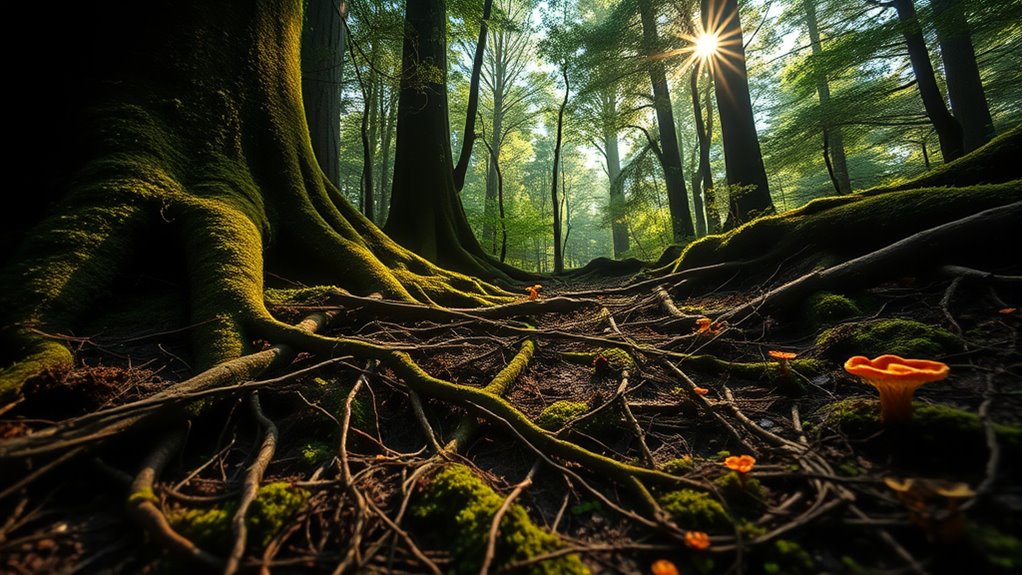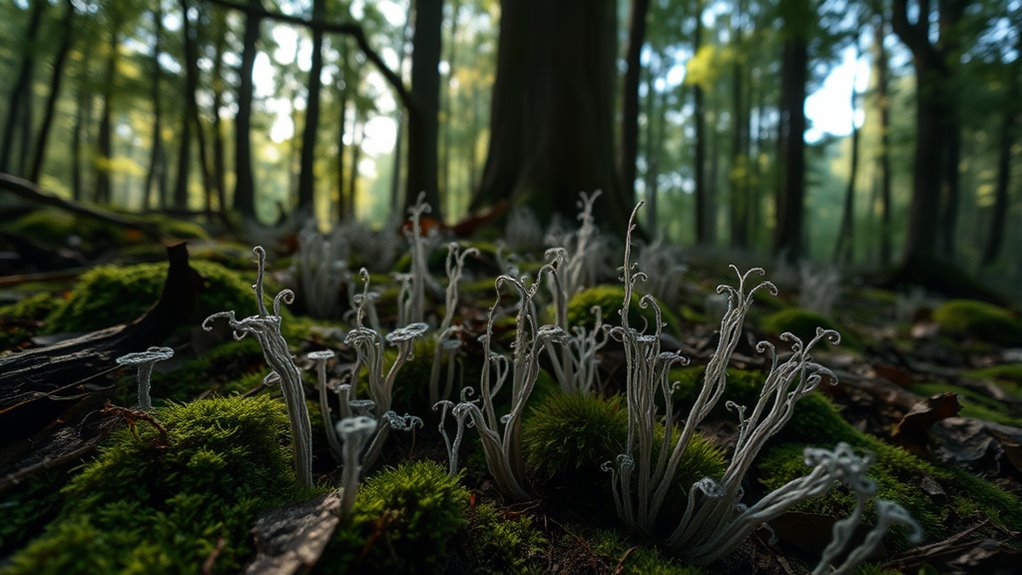You’re discovering that trees communicate underground through mycorrhizal networks, where fungi connect roots and act as biological internet cables. These networks transmit chemical signals that help trees share resources, warn each other about pests, and respond to environmental stresses. By working together, trees form a cooperative community supported by fungi. If you continue exploring, you’ll uncover how this hidden communication shapes forests’ resilience and interconnected life.
Key Takeaways
- Trees communicate underground via mycorrhizal networks formed by symbiotic fungi connecting roots.
- Chemical signals travel through fungal hyphae, allowing trees to warn neighbors and share resources.
- These networks enable rapid responses to environmental stress, pests, and nutrient shortages.
- Fungal communication fosters cooperation among trees, supporting ecosystem health and resilience.
- This underground “conversation” reveals trees are interconnected, highly responsive, and vital to forest stability.

Trees may seem silent, but recent scientific research reveals they communicate in surprisingly sophisticated ways. One of the most fascinating methods they use involves fungal communication through underground signaling networks. These networks, known as mycorrhizal networks, connect trees and plants via symbiotic fungi that colonize their roots. When you look beneath the forest floor, you’ll find a complex web where fungi act as the messengers, transmitting information between trees in ways you might never have imagined.
Through these underground signaling systems, trees can share resources, warn each other of danger, and even coordinate growth. When a tree is under attack by pests or diseases, it releases chemical signals through the mycorrhizal fungi. These signals travel along the fungal hyphae—tiny thread-like structures—reaching neighboring trees. The nearby trees then respond by boosting their own defenses, producing chemicals that make them less attractive to pests. This form of fungal communication acts like an early warning system, allowing the forest community to mobilize collectively against threats.
Trees signal danger through fungi, alerting neighbors and activating defenses collectively.
You might wonder how this communication actually works. It’s not just random signaling; it’s a highly organized process rooted in underground signaling pathways. The fungi serve as biological internet cables, transmitting chemical cues efficiently across vast underground networks. These signals can carry information about nutrient shortages, environmental stress, or upcoming changes in weather. As a result, trees can adapt more quickly to their surroundings. For instance, if one tree experiences drought conditions, it can signal its neighbors to adjust their water uptake or root growth accordingly, improving the resilience of the entire ecosystem.
This underground communication isn’t limited to just sharing warnings. It also involves resource exchange. Healthy trees can send excess carbon, sugars, or nutrients through the mycorrhizal network to weaker or younger trees, helping them grow and survive. In this way, the network fosters cooperation rather than competition, creating a cooperative community rooted in fungal-mediated communication. It’s like an underground social network, where trees support each other in ways that once seemed impossible to imagine.
Understanding fungal communication and underground signaling reveals just how interconnected and responsive trees really are. It challenges the notion of trees as solitary organisms, showing instead that they participate in a complex, dynamic web of life beneath our feet. As you walk through a forest, keep in mind that beneath the surface, an intricate conversation is constantly taking place—one that’s key to the health and resilience of the entire ecosystem. Recent studies have also shown that the colorful fungi involved in these networks play a crucial role in maintaining the health and stability of forest environments.
Frequently Asked Questions
Can Mycorrhizal Networks Transfer Harmful Substances Between Trees?
You might wonder if mycorrhizal networks transfer harmful substances between trees. These networks use chemical signaling to communicate, but they can also enable disease transmission if pathogens travel through them. While they help share nutrients and warnings about danger, they can inadvertently spread harmful substances or diseases. So, yes, mycorrhizal networks can transfer both beneficial signals and potentially harmful pathogens, impacting tree health in complex ways.
How Do Different Tree Species Communicate Through These Underground Networks?
Imagine trees as neighborhood neighbors, each with their own language. Through mycorrhizal networks, you see, they send signals—species-specific signaling—that help them share messages like warnings or nutrients. This cross-species communication enables different tree species to cooperate or alert each other to danger. You might not see it, but underground, these networks act like a vibrant community, fostering understanding and survival among diverse trees.
Are Mycorrhizal Networks Affected by Climate Change or Pollution?
You might wonder if pollution impact and climate effects threaten mycorrhizal networks. Sadly, pollution can harm these underground connections by contaminating soil and reducing fungal diversity. Climate effects, like increased temperatures and altered rainfall, also disrupt these networks, making it harder for trees to communicate and share resources. Protecting our environment helps preserve these essential systems, ensuring healthy forests and resilient ecosystems for the future.
Can Humans Enhance or Disrupt These Natural Communication Systems?
You can influence mycorrhizal networks by either enhancing or disrupting fungal signaling and nutrient exchange. Human activities like planting diverse species or reducing pollution can support these natural systems, boosting tree health. Conversely, practices like soil disturbance or excessive chemical use can hinder fungal communication. By understanding these processes, you can help protect and strengthen the essential links that sustain forests and ecosystems.
Do Mycorrhizal Connections Influence Forest Resilience During Droughts?
Have you ever wondered if underground connections help forests survive droughts? Mycorrhizal networks play a crucial role in nutrient sharing and disease resistance, which boost resilience during dry periods. These fungal links enable trees to support each other by distributing water and nutrients, enhancing their collective strength. So, yes, mycorrhizal connections markedly influence forest resilience, helping ecosystems withstand environmental stresses and recover more quickly from droughts.
Conclusion
Now that you understand how mycorrhizal networks act like a silent internet beneath the forest floor, you see trees aren’t alone—they’re part of a vibrant, underground conversation. Like a web connecting every leaf and root, these networks transfer nutrients and messages, nurturing the forest’s heartbeat. Recognizing this hidden communication makes you realize that trees, in their quiet way, are always talking, sharing life’s secrets through an invisible, yet powerful, underground symphony.









